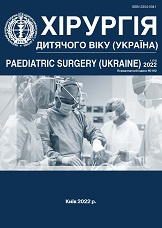Laparoscopic simultaneous diverticuloectomy of the bladder and ureterocystostomy by Lich-Gregoir
DOI:
https://doi.org/10.15574/PS.2022.74.100Keywords:
diverticulum of bladder, laparoscopy, ureterocystostomyAbstract
To show the advantages of laparoscopic technique as a method for the best visualization and simplification of the method of surgical intervention in diverticulum of bladder, and the technique of antireflux surgery for vesicoureteral reflux of different degrees in children.
Purpose - to share experiences and demonstrate the technique of making the antireflux mechanism, and to show life hacks to make the bladder diverticulectomy easier.
Materials and methods. In 2016-2021 there were 23 patients with VUR of different degrees. Two of them had a bladder diverticulum. In one case - ectopia of the ureter into the diverticulum. In another case the ingress of the ureter was anatomically correct.
Results. Steps of operation. The patient’s position is on the back with a roller under the lumbar region. The optical port is installed transumbilically. Two working ports are installed: on the middle line between the navel and the «spina illiaca anterior» of pelvic. Pneumoperitoneum - 8-10 mm Hg.
Technique. At the same time with laparoscopy, cystoscopy to better visualize of edge of the diverticulum. After that, the diverticulum was excised and the walls of the bladder were sutured. In the case of ectopia of the ureter into the diverticulum made ureterocystomy, followed by antireflux protection by Lich-Gregoir. And in another case only antireflux protection was made.
Specificity of antireflux protection technique. Marking and forming of the submucosal tunnel does by a hook and / or scissors. Previously do the traction of the bladder over the ureter in the direction of the anterior abdominal wall. The next step is to fix the bladder with three holders, which are output. This makes it easier to dissect the layers of the bladder. The ureter was placement into the sub mucous tunnel. And muscular tunica and walls were sutured of material 4/0.
Specific of drainage. When antireflux protection perform - the stent was not installed into the ureter. At ureterocystoneostomy - the stent was placements for a period of 30 days.
Drainage of abdominal was performed in all cases. An urinary catheter was additionally placements in the bladder for 3 days.
There were no intraoperative or postoperative complications. Duration of surgery up to 180 minutes.
Conclusions. Laparoscopic ureterocystoneostomy is, in our opinion, more convenient for the surgeon and more gentle for the patient. Allows you to significantly reduce the number of postoperative complications. This laparoscopic diverticulectomy of the bladder has been demonstrated, showing a significant advantage in the convenience of visualization of the diverticulum and easier removal of the diverticulum of the bladder.
The study was carried out in accordance with the principles of the Declaration of Helsinki. Informed consent of parents and children was obtained for the study.
No conflict of interests was declared by the authors.
References
Garat JM, Angerri O, Caffaratti J, Moscatiello P, Villavicencio H. (2007). Primary congenital bladder diverticula in children. Urology. 70: 984-988. https://doi.org/10.1016/j.urology.2007.06.1108; PMid:18068458
Macejko AM, Viprakasit DP, Nadler RB. (2008). Cystoscope- and robot-assisted bladder diverticulectomy. J Endourol. 10: 2389-2391. https://doi.org/10.1089/end.2008.0385; PMid:18937603
Moralioglu S, Bosnali O, Celayir AC, Sahin C. (2014). Extravesical approach in paraureteral bladder diverticulum. A case report. W Indian Med J. 63: 201-203. https://doi.org/10.7727/wimj.2012.113; PMid:25303263 PMCid:PMC4655664
Downloads
Published
Issue
Section
License
Copyright (c) 2022 Paediatric Surgery (Ukraine)

This work is licensed under a Creative Commons Attribution-NonCommercial 4.0 International License.
The policy of the Journal “PAEDIATRIC SURGERY. UKRAINE” is compatible with the vast majority of funders' of open access and self-archiving policies. The journal provides immediate open access route being convinced that everyone – not only scientists - can benefit from research results, and publishes articles exclusively under open access distribution, with a Creative Commons Attribution-Noncommercial 4.0 international license(СС BY-NC).
Authors transfer the copyright to the Journal “PAEDIATRIC SURGERY.UKRAINE” when the manuscript is accepted for publication. Authors declare that this manuscript has not been published nor is under simultaneous consideration for publication elsewhere. After publication, the articles become freely available on-line to the public.
Readers have the right to use, distribute, and reproduce articles in any medium, provided the articles and the journal are properly cited.
The use of published materials for commercial purposes is strongly prohibited.

